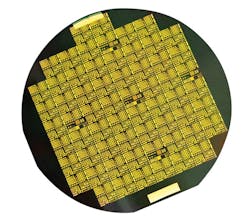GaN-On-Diamond Breakthrough Promises To Shrink Transistors
When it comes to reliability, high-performance semiconductors are largely impacted by operating temperature. Gallium-nitride (GaN) devices, which are capable of high power densities, must dissipate high amounts of heat to be effective and achieve high reliability. By using GaN-on-diamond wafers, TriQuint Semiconductor, Inc. has managed to reduce device temperature and increase thermal conductivity (see photo). According to the firm, this technology will enable new generations of RF power amplifiers (PAs) that reduce size or increase power output by a factor of three compared to today’s GaN solutions.
The firm successfully transferred a semiconductor epitaxial overlay onto a synthetic diamond substrate, preserving key GaN crystalline layers. As a result, the GaN semiconductors benefit from the high thermal conductivity of the diamond substrate and low thermal resistance at the boundary between the GaN and diamond materials. This achievement demonstrates the feasibility of GaN-on-diamond HEMT devices.
According to results attained to this point, TriQuint has achieved the goal of a three-fold improvement in heat dissipation while preserving RF functionality, which was the primary objective of the Defense Advanced Research Projects Agency’s (DARPA’s) Near Junction Thermal Transport (NJTT) program. NJTT focuses on device thermal resistance “near the junction” of the transistor. Thermal resistance inside device structures can be responsible for more than 50% of normal operational-temperature increases. In its research, TriQuint has shown that GaN RF devices can operate at a much higher power density and in smaller sizes by leveraging thermal-management techniques.
Additional fabrication improvements and extensive device testing are underway. Their goal is to optimize the epitaxial-layer transfer process and fully characterize the enhancements that can be achieved in these new HEMT devices. TriQuint demonstrated its new GaN-on-diamond, high-electron mobility transistors (HEMTs) in conjunction with partners at the University of Bristol, Group4 Labs, and Lockheed Martin under the NJTT program.
About the Author

Nancy Friedrich
RF Product Marketing Manager for Aerospace Defense, Keysight Technologies
Nancy Friedrich is RF Product Marketing Manager for Aerospace Defense at Keysight Technologies. Nancy Friedrich started a career in engineering media about two decades ago with a stint editing copy and writing news for Electronic Design. A few years later, she began writing full time as technology editor at Wireless Systems Design. In 2005, Nancy was named editor-in-chief of Microwaves & RF, a position she held (along with other positions as group content head) until 2018. Nancy then moved to a position at UBM, where she was editor-in-chief of Design News and content director for tradeshows including DesignCon, ESC, and the Smart Manufacturing shows.
